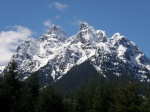Feet Joke: choose the right
+4
chansen
Kev Bailey
Will Heath
furuya
8 posters
Page 1 of 1
 Re: Feet Joke: choose the right
Re: Feet Joke: choose the right
I think a foot should be directly under the peak, neither of these photos show this option.
Will
Will

Will Heath- Member
 Re: Feet Joke: choose the right
Re: Feet Joke: choose the right
The feet need to be supporting the centres of weight that are where ridges run out from the summit. So I'd say that the first one is technically correct but the feet look too equidistant. A nice problem to have to solve. Lovely stone.

Kev Bailey- Admin
 Re: Feet Joke: choose the right
Re: Feet Joke: choose the right
I agree with Kev. The first image is better.
When I look at the feet, they seem to do the best at holding the visual weight without throwing too many feet at it. The original image (with more feet) also seems too busy to me. The image with fewer feet allows me to focus more on the stone.
Having said that, it is a wonderful problem to have. The stone is fantastic (all of them from the exhibit have been). I really appreciate you sharing them.
Best regards,
Christian
When I look at the feet, they seem to do the best at holding the visual weight without throwing too many feet at it. The original image (with more feet) also seems too busy to me. The image with fewer feet allows me to focus more on the stone.
Having said that, it is a wonderful problem to have. The stone is fantastic (all of them from the exhibit have been). I really appreciate you sharing them.
Best regards,
Christian
chansen- Member
 Re: Feet Joke: choose the right
Re: Feet Joke: choose the right
I have no experience in this, however I do agree that the first picture "looks" or feels better but IMHO the elaborate stand draws my eye away (a visual distraction) from the stone on display?
G
G

gman- Member
 Re: Feet Joke: choose the right
Re: Feet Joke: choose the right
Hi Marco... I love such a distinct question on such an interesting stone. Kev caught my thought exactly in principal, though I would prefer the second image (5-feet choice) to the first image (4-feet) choice for reasons additional to Kev's... and might consider a third image as my favored choice. it is a riddle or mystery (rather than a "joke") to consider careful crafting of this stand.
In addition to Kev's criteria, I would add that having an open-space-between-feet directly in the center of the stones front is distracting, even if the spaces on each side were not of similar length; this is a distraction for the 4-feet daiza-front illustrated. It is also best to not have a foot at the near horizontal center of the stone; this is a distraction for the 5-feet daiza-front illustrated.
In addition to the actual circumference (footprint) of this stone establishing the placement of ridges running-out, the wonderful wrinkles on the stone establish visual ridges. It gives the daiza designer some leeway to craft feet along the apparent ends of ridges which might not be the exact ridgeline on the stones perimeter. The daiza carver might choose the ridges which are most prominent (whether expressed by an actual or apparent ridgeline or a combination of each).
I would prefer three or five rather than four feet for a Japanese-style daiza. I realize that contrast with some others opinions including one expressed previously on this forum. To me, the asymmetric balance using an odd number of feet is aesthetically better. Someone else might count the openings between feet and choose four feet over three or five feet; but that is uncommon.
We probably agree that the feet at each end are appropriate. Is there one other place to insert a foot, stabilize the stone & indicate a ridgeline which doesn't end in bisecting the stone near its middle? I think that there is. It ends at a wrinkle off-center near one of the 4-feet daiza illustrated.

Close view of 3 feet (in this photo, it looks as though it could be placed a bit more to the left, but it looked fine in zoomed detail on Photoshop)...

In addition to Kev's criteria, I would add that having an open-space-between-feet directly in the center of the stones front is distracting, even if the spaces on each side were not of similar length; this is a distraction for the 4-feet daiza-front illustrated. It is also best to not have a foot at the near horizontal center of the stone; this is a distraction for the 5-feet daiza-front illustrated.
In addition to the actual circumference (footprint) of this stone establishing the placement of ridges running-out, the wonderful wrinkles on the stone establish visual ridges. It gives the daiza designer some leeway to craft feet along the apparent ends of ridges which might not be the exact ridgeline on the stones perimeter. The daiza carver might choose the ridges which are most prominent (whether expressed by an actual or apparent ridgeline or a combination of each).
I would prefer three or five rather than four feet for a Japanese-style daiza. I realize that contrast with some others opinions including one expressed previously on this forum. To me, the asymmetric balance using an odd number of feet is aesthetically better. Someone else might count the openings between feet and choose four feet over three or five feet; but that is uncommon.
We probably agree that the feet at each end are appropriate. Is there one other place to insert a foot, stabilize the stone & indicate a ridgeline which doesn't end in bisecting the stone near its middle? I think that there is. It ends at a wrinkle off-center near one of the 4-feet daiza illustrated.

Close view of 3 feet (in this photo, it looks as though it could be placed a bit more to the left, but it looked fine in zoomed detail on Photoshop)...


Chris Cochrane- Member
 Re: Feet Joke: choose the right
Re: Feet Joke: choose the right
Every stone is what it is & cannot be expected to be the perfect model.
This stone is heavier on its left side & rises closer to vertical on that side from its foot. You might expect in the traditional stone that the stones peak would also be closer to the left than right side, but that is not the case for Rafael's suiseki. By placing a single middle-leg toward the left side of the stone, its visual flow is reinforced as directed toward the right. While that directional flow is inconsistent with the placement of the peak, it could be the best choice for this stone. The relatively short ridgeline on the right side falls in a straight line down the right profile of the stone to speed the eye in that direction. It is arguable, however.
Would any placement of a single foot to the right-of-center support the stone, as well, in reinforcing its visual flow toward the left?
In whichever direction the feet are fewer or more distantly placed underneath the stone, the directional flow of the stone should be stronger.
Thanks for the riddle, Marco. Has Rafael declared an answer?
This stone is heavier on its left side & rises closer to vertical on that side from its foot. You might expect in the traditional stone that the stones peak would also be closer to the left than right side, but that is not the case for Rafael's suiseki. By placing a single middle-leg toward the left side of the stone, its visual flow is reinforced as directed toward the right. While that directional flow is inconsistent with the placement of the peak, it could be the best choice for this stone. The relatively short ridgeline on the right side falls in a straight line down the right profile of the stone to speed the eye in that direction. It is arguable, however.
Would any placement of a single foot to the right-of-center support the stone, as well, in reinforcing its visual flow toward the left?
In whichever direction the feet are fewer or more distantly placed underneath the stone, the directional flow of the stone should be stronger.
Thanks for the riddle, Marco. Has Rafael declared an answer?

Chris Cochrane- Member
 Re: Feet Joke: choose the right
Re: Feet Joke: choose the right
Hi John... That is a great option which focuses the flow of the stone toward the left. I can see reason to direct the stone toward the left, too.
Do you like the second foot to the left located between the wrinkles reaching to the base of the stone? It is another one of those judgement calls. Underneath this relatively gentle curve of the stone, the daiza carver has created a break in the daiza wall which suggest he wants it seen as a ridgeline. Your perception is sensitive to the daiza wall as well as the stone.
We could see the wrinkles as the profile of subordinate hills which reach directly toward the viewer. In this case neither the wrinkles nor the footprint of the stone (nor any obvious ridge) ends where the 2nd foot from the right sits, but we can imagine a ridge there if contemplating the wrinkles as the profile of secondary hills seen in two dimensions.
A problem for me would be choosing four feet if I could find three or five. Your 4-feet option is a good choice and perhaps better than either original option, which each (especially the 4-feet original daiza illustration) express too much symmetry.
Do you like the second foot to the left located between the wrinkles reaching to the base of the stone? It is another one of those judgement calls. Underneath this relatively gentle curve of the stone, the daiza carver has created a break in the daiza wall which suggest he wants it seen as a ridgeline. Your perception is sensitive to the daiza wall as well as the stone.
We could see the wrinkles as the profile of subordinate hills which reach directly toward the viewer. In this case neither the wrinkles nor the footprint of the stone (nor any obvious ridge) ends where the 2nd foot from the right sits, but we can imagine a ridge there if contemplating the wrinkles as the profile of secondary hills seen in two dimensions.
A problem for me would be choosing four feet if I could find three or five. Your 4-feet option is a good choice and perhaps better than either original option, which each (especially the 4-feet original daiza illustration) express too much symmetry.

Chris Cochrane- Member
 Re: Feet Joke: choose the right
Re: Feet Joke: choose the right
Both bases look pleasing to me though at a push I’d go for the first one, but more importantly thanks for showing such a beautiful stone! 

Fuzzy- Member
 Similar topics
Similar topics» Choose IMAGE or choose LANDSCAPE ...?
» i heard they like tight feet...
» Celtis L. one year 12 feet tall [ 4 m ? ]
» An observation on the average height of say 2 to 3 feet [61 to 91 cm ] with Japanese trees
» WORST JOKE!
» i heard they like tight feet...
» Celtis L. one year 12 feet tall [ 4 m ? ]
» An observation on the average height of say 2 to 3 feet [61 to 91 cm ] with Japanese trees
» WORST JOKE!
Page 1 of 1
Permissions in this forum:
You cannot reply to topics in this forum









